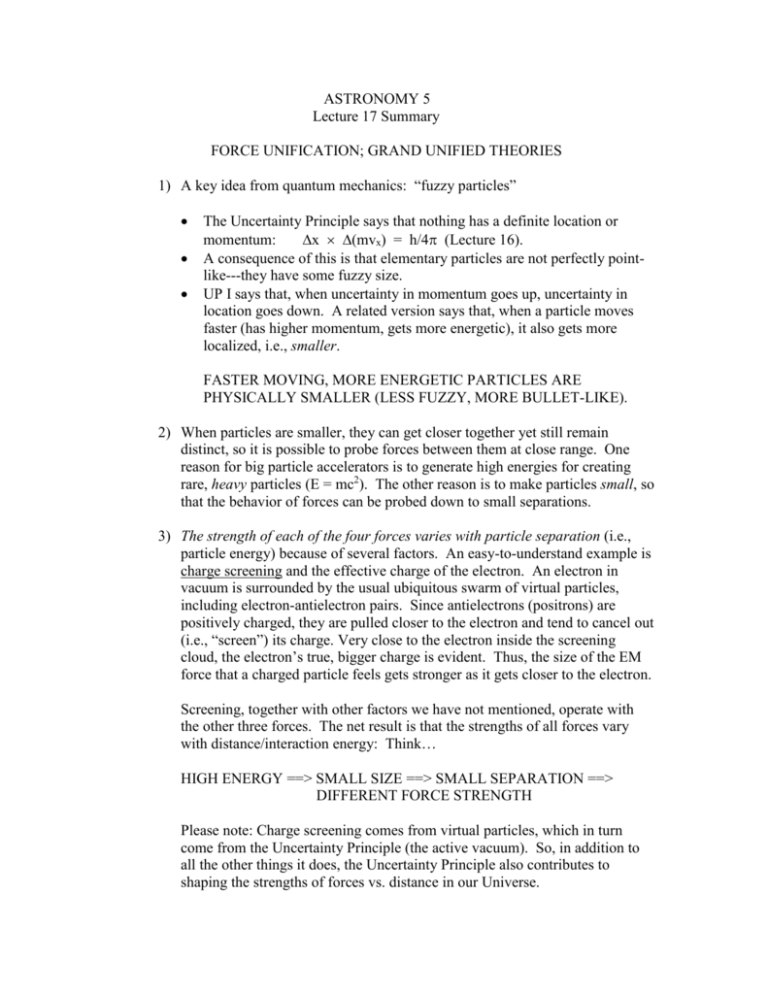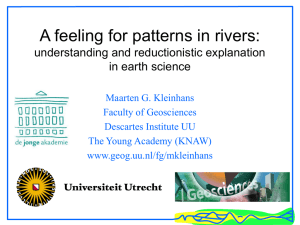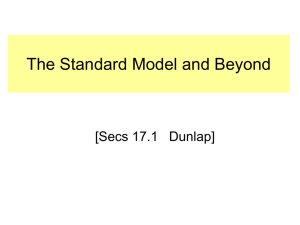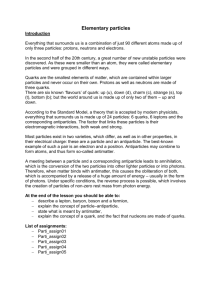Lecture 17
advertisement

ASTRONOMY 5 Lecture 17 Summary FORCE UNIFICATION; GRAND UNIFIED THEORIES 1) A key idea from quantum mechanics: “fuzzy particles” The Uncertainty Principle says that nothing has a definite location or momentum: x (mvx) = h/4 (Lecture 16). A consequence of this is that elementary particles are not perfectly pointlike---they have some fuzzy size. UP I says that, when uncertainty in momentum goes up, uncertainty in location goes down. A related version says that, when a particle moves faster (has higher momentum, gets more energetic), it also gets more localized, i.e., smaller. FASTER MOVING, MORE ENERGETIC PARTICLES ARE PHYSICALLY SMALLER (LESS FUZZY, MORE BULLET-LIKE). 2) When particles are smaller, they can get closer together yet still remain distinct, so it is possible to probe forces between them at close range. One reason for big particle accelerators is to generate high energies for creating rare, heavy particles (E = mc2). The other reason is to make particles small, so that the behavior of forces can be probed down to small separations. 3) The strength of each of the four forces varies with particle separation (i.e., particle energy) because of several factors. An easy-to-understand example is charge screening and the effective charge of the electron. An electron in vacuum is surrounded by the usual ubiquitous swarm of virtual particles, including electron-antielectron pairs. Since antielectrons (positrons) are positively charged, they are pulled closer to the electron and tend to cancel out (i.e., “screen”) its charge. Very close to the electron inside the screening cloud, the electron’s true, bigger charge is evident. Thus, the size of the EM force that a charged particle feels gets stronger as it gets closer to the electron. Screening, together with other factors we have not mentioned, operate with the other three forces. The net result is that the strengths of all forces vary with distance/interaction energy: Think… HIGH ENERGY ==> SMALL SIZE ==> SMALL SEPARATION ==> DIFFERENT FORCE STRENGTH Please note: Charge screening comes from virtual particles, which in turn come from the Uncertainty Principle (the active vacuum). So, in addition to all the other things it does, the Uncertainty Principle also contributes to shaping the strengths of forces vs. distance in our Universe. 4) Some forces get stronger at small separations, others get weaker. As the strengths of two forces become comparable, the distinction between them blurs, and they can behave like one “unified” force. Force strength equality is the first of three key elements in FORCE UNIFICATION. The weak and electromagnetic forces merge at 100 GeV to become the electroweak force (100 GeV is 100 times the mass-energy of a proton). This idea, which started out as a theory, has been verified in accelerator experiments and is now known to be correct, ESTABLISHING THAT FORCE UNIFICATION ACTUALLY DOES OCCUR. Thus, we already know that there are not really four forces of nature, but at most three. Next, the electroweak and strong forces are predicted to merge at 1015 GeV to become the Grand Unified Force (Grand Unified Theory, or GUT). The exact GUT theory is not known and there are many versions floating around, but the essential nature of the theory is fairly clear. Finally, gravity is believed to unify with all the other forces at the extraordinarily high energy of 1019 GeV. This is essentially the limit of energies that can be achieved in our Universe, called the Planck energy. It corresponds to the temperature at the Big Bang. We’ll learn more about the Planck energy when we talk about the very beginning of the Universe. There is no reliable theory for the ultimate union between gravity and the GUT force (sometimes called quantum gravity). Making this final step requires unifying quantum mechanics with gravity, which has proved very difficultunwanted infinities keep appearing. Einstein spent the end of his life looking for this ultimate unified theory and failed. The hoped-for, as-yet-undiscovered, all-encompassing superforce is affectionately called the “Theory of Everything” (TOE). One promising version is called string theory (see Lecture 22). 5) The schematic diagram on the next page summarizes the way the strengths of the four forces are thought to become unified at high energies. Gravity is indicated with a question mark because the nature of this ultimate unification is still uncertain. 6) Recall that 1 GeV is the mass-energy (E = mc2) of a proton (Lecture 16). Thus, the GUT unification energy of 1015 GeV is a thousand trillion (1015) photon masses, and the unification energy of quantum gravity is 10 million trillion (1019) photon masses. By comparison, the maximum energy that we can generate in terrestrial accelerators is only 10,000 GeV. We therefore cannot do experiments at the high unification energies to test the theories---the Universe (when hot and dense) is the only particle accelerator we have. ? The next diagram summarizes how the forces merged at higher temperatures and earlier times: 7) The second key element in force unification is that the originally separate force carrier particles (called “bosons,” Lecture 15) must merge to make one family of force carrier particles. For example, to make the GUT, we must merge the strong force with the electroweak force. That means that the new force bosons (carriers) of the GUT must be a union of the W+, W, Z, and photons of the electroweak force with the gluons of the strong force (see force table in Lecture 15 for a review of these names). That is not all…the high unification energy enables the creation of entirely new, heavy force carriers that are actually combinations of gluons and (W,Z,photons). All the GUT force carriers are very massive (1015 GeV, same energy as the energy of unification), and collectively they are known as “X-bosons.” 8) The third and final element in force unification is that the originally separate matter particles must merge to become one family of matter particles. Please note that the exchange of a force-carrier boson usually changes the identity of the particles involved. An example is neutron decay (Lecture 15), where the emission of a W- changed a down quark into an up quark, which changed the neutron into a proton. (Photons and gravitons are an exception to this rule…exchanging them does not change the identity of the particles involved). More generally, the absorption and emission of gluons turn quarks into other kinds of quarks, while W’s and Z’s turn quarks and leptons into their opposite number in the same family (i.e., up into down, charm into strange, electron into electron neutrino, etc.) But none of the bosons of the four forces today can turn quarks into leptons or vice versa. EACH OF THE FOUR FORCES TODAY CAN TRANSFORM PARTICLES ONLY WITHIN THE REALM ACCESSIBLE TO IT. To have complete unification of forces, all particles must feel the same force, and therefore the barrier between leptons and quarks must disappear. Hence, the final element of unification is that the new GUT X-bosons are able to turn leptons into quarks and vice versa. This eliminates the last barrier between quarks and leptons. To sum up, at high energies: The electroweak force and the strong force have the same strength. The original force carrier bosons of the strong force (gluons) and the electroweak force (W, Z, and photon) are subsumed within a larger set of bosons, which now include mixed bosons called X-bosons. These are very heavy and are therefore produced only at the GUT energy. All distinctions between the original particle families (quarks and leptons) are erased, and each can now transform freely into the other via the emission and absorption of X-bosons. Force unification is now complete. 9) In retrospect, there are three key ingredients in Grand Unification: The forces have to change strength as a function of energy and become equal at the unification energy. This is possible because particles are smaller at high energy and can get closer together. One simple reason why forces change strength at small separations is charge screening by virtual particles from the vacuum (created by the Uncertainty Principle), but other factors are involved that are too complex to explain here. A new kind of force-carrier boson has to be created that is a cross between gluons and W+Z+photons. These new X-bosons can transform quarks into leptons and vice versa. The X’s are in some sense a “blend” of the original bosons of the two original forces, strong and electroweak. The X-bosons are very massive and they can be created only at high energies. Hence, at low energies (today), the X-bosons don’t exist, and the two forces appear distinct…they can’t mix. At the unification energy, the X’s appear, and the unified character becomes apparent. 10) Grand Unification is the easiest unification to understand. The unification of the W’s and Z’s with the photon to make the electroweak force at lower temperatures is essentially similar but mathematically more complicated. The ultimate unification of gravity with the GUT force is suspected to involve a family of even more massive super-bosons that blend gravitons with the Xbosons of the GUT force. 11) It is suspected by many that the Universe was created at the instant when gravity split apart from the other three forces, which created both space and time. The Big Bang may have been the first splitting. 12) Because forces unify at successively higher energies going back in time, they must have successively split apart going forward in time, as the Universe expanded and cooled. This gave rise to several epochal events in the early Universe, as we shall discuss.








